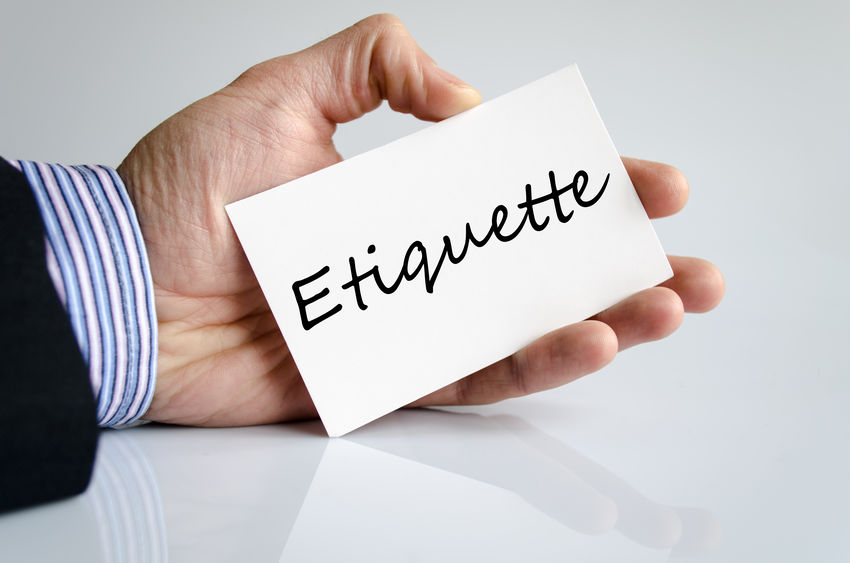A Modern Definition of Etiquette
Recently on the Merriam-Webster Dictionary online, the featured Word of the Day was “etiquette.” Their definition reads: “The conduct or procedure required by good breeding or prescribed by authority to be observed in social or official life.”
While this definition may be accurate, its context is more appropriate for another era. So, how do we define “etiquette” in 2019?
While this definition may be accurate, its context is more appropriate for another era. So, how do we define “etiquette” in 2019?
A Little History
The word “etiquette” originated from the French word “estiquette” meaning “ticket” or “label.” It references the custom of a king setting forth ceremonial rules to be observed by members of the court.
Now, as then, etiquette is about the ways we show up recognizably respectful in our behaviors. It is a reflection of the times yet, at its core, are the principles of good manners: respect, courtesy, tact, restraint, self-command, and responsibility.
Now, as then, etiquette is about the ways we show up recognizably respectful in our behaviors. It is a reflection of the times yet, at its core, are the principles of good manners: respect, courtesy, tact, restraint, self-command, and responsibility.
Proper Behaviors
Etiquette rules have always existed. Like us, they have evolved with changes in society and technology. The "how-to's" and "when-to's" of etiquette change over time, though the need for etiquette know-how does not.
A friend of mine on Facebook, Tom W. Bell, wrote to me: “Etiquette comes not so much from lifting your pinkie as from lifting others’ spirits.”
Though there are ways of holding and not holding objects properly, and ways of doing things that are recognized by others as exhibiting good manners, etiquette's inspiration is always about connecting with others, acting in ways that help them to feel welcome and accepted.
A friend of mine on Facebook, Tom W. Bell, wrote to me: “Etiquette comes not so much from lifting your pinkie as from lifting others’ spirits.”
Though there are ways of holding and not holding objects properly, and ways of doing things that are recognized by others as exhibiting good manners, etiquette's inspiration is always about connecting with others, acting in ways that help them to feel welcome and accepted.
The guidelines are the tangibles of how it looks to others to show up in integrity. When you are mindful of where you are and who you are with, have an awareness of what is socially acceptable, and act with a kind heart, you will be able to solve for particular situations harmoniously.
Etiquette is not about putting on airs, but is not without pretense. However – pretense of the good kind. As in when you’re making it possible for something real and beneficial to happen. You might not feel like being kind or courteous, but you are anyway. When you take an action of kindness in one moment, you’ll never be sorry in the next.
Etiquette is not about putting on airs, but is not without pretense. However – pretense of the good kind. As in when you’re making it possible for something real and beneficial to happen. You might not feel like being kind or courteous, but you are anyway. When you take an action of kindness in one moment, you’ll never be sorry in the next.
Etiquette in 2019
Etiquette is a set of guidelines for expected social behavior. We share a world with other people and etiquette assumes a commitment to personal responsibility and civility.
Etiquette is ongoing learning through the practice of:
- Personal greetings, introductions and interactions.
- Virtual and electronic greetings, introductions, and interactions.
- Casual and formal dining skills; socializing when food is involved.
- Self-presentation skills.
- Conversation and communication skills.
- Personal and social space considerations.
- Inviting, including , and thanking others.
With these considerations, my working definition of etiquette is:
The mindful, personal , and intentional practice of creating respectful, kind and orderly interactions within family, social, professional, educational, neighborly and public environments.
The mindful, personal , and intentional practice of creating respectful, kind and orderly interactions within family, social, professional, educational, neighborly and public environments.
Examples:
- Listening to understand.
- Being sincere, authentic and tactful.
- Seeking win-win situations.
- Helping others feel welcome and comfortable.
- Eating and sharing a meal in an orderly fashion.
- Sending acknowledgments and Thank You's.
- Encouraging others.
- Opening doors for others.
- Offering your seat on a crowded train.
- Being forgiving.
- Offering to help your co-worker finish an overdue task.
- Embracing differences.
- Ensuring that letters, emails, texts, and social media posts are clear, concise, and kind.
- Taking responsibility for your words and actions, including apologizing for mistakes.
- Excluding no one from kindness.
Am I practically perfect at this? Heavens No! But, like you, I am aiming!
Living an etiquette-ful life is at the foundation of maintaining a free and civil society. It is never legislated and is open to every individual to choose.
Contributor, Candace Smith is retired, national award-winning secondary school educator, Candace Smith teaches university students and professionals the soft skills of etiquette and protocol. She found these skills necessary in her own life after her husband received international recognition in 2002. Plunged into a new “normal” of travel and formal social gatherings with global leaders, she discovered how uncomfortable she was in many important social situations. After extensive training in etiquette and protocol, Candace realized a markedly increased confidence level in meeting and greeting and dining skills and was inspired to share these skills that will help others gain comfort and confidence in dining and networking situations. Learn more at http://www.candacesmithetiquette.com/
Etiquette Enthusiast, Maura J Graber, is the Site Editor for the Etiquipedia©️ Etiquette Encyclopedia


No comments:
Post a Comment
Note: Only a member of this blog may post a comment.